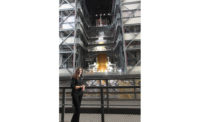A couple of years ago, one of our teams was working in an active hospital, adjacent to a neonatal intensive care unit. Like all work in sensitive areas, the crew would measure levels of dust, particles, noise and air pressure to ensure construction wasn’t posing a risk to the NICU.
This is standard operating procedure, but our team saw risks. What happened in between the times when workers would take a reading? A few project team members saw their smartphones and realized they literally had the technology to change this system in their hands.
At the same time, a different Skanska project team at Duke University was investigating how to develop custom applications for mobile devices. The team recognized the power of real time information delivered through a simple user interface, and was actively developing several concepts for apps to use on jobsites.
The two teams collectively developed a product we’re calling the iSite Monitor, an iOS app that measures environmental conditions in real time and alerts the project team to any issues the moment they emerge. That’s minutes saved with some of the hospitals most at-risk patients. It’s such a good idea, we’re working to implement it on healthcare projects nationwide.
We didn’t get there by accident or luck, though. Since 2010, Skanska has invested in an organization whose sole purpose is to create a culture of innovation and actively manage the innovation process. We accomplish this by connecting people across a highly decentralized organization, and providing them the tools and funding to collaborate, implement and share their ideas.
This organization helps foster a culture of innovation. Innovation is often born from diverse thought. In a decentralized company, where most people work on small remote project teams, we have to provide the means and methods to connect people with different perspectives, and different experiences. In the example above, the program connected teams in Florida and North Carolina and provided the means to effectively collaborate to solve a problem.
Innovation requires more than words of encouragement to move ideas forward. Through our Innovation Grant Program, we provide funding to individuals and teams to develop and transform their ideas into repeatable solutions. The grant funding allows innovators to tap into local universities or external resources to accelerate the development and refinement of their ideas.
Combining effective communications with active process management allows us to optimize the value of the innovations. The first installation of the iSite Monitor was a grand science experiment with sensors mounted inside metal boxes, connected to multiple computers. Today, because of our combined efforts, it has evolved into a commercial product with a custom enclosure available to all Skanska jobsites.
This culture of innovation encourages entrepreneurism and pushes people to think beyond standard operating norms. This is reinforced through our innovation grant program, providing tangible funding to support ideas. If a field team has a great idea, local budgets are no longer a constraint to bring their idea to life. You cannot underestimate the effect on employees who fully realize there are resources to support the development of their ideas.
Skanska has invested in the a means – the Innovation Grant Program – and the infrastructure – the Innovation Group – that provided the funding and support to transform ideas into repeatable solutions. The Innovation Program may not originate the idea, but provides the engine that harnesses innovation to deliver value to clients and improve the way we work.
Some would argue that innovation isn’t something you can orchestrate. I would counter that Innovation itself may be organic, but in order to maximize the opportunities for innovation and optimize the value of creative ideas, the process must be actively managed.



Post a comment to this article
Report Abusive Comment